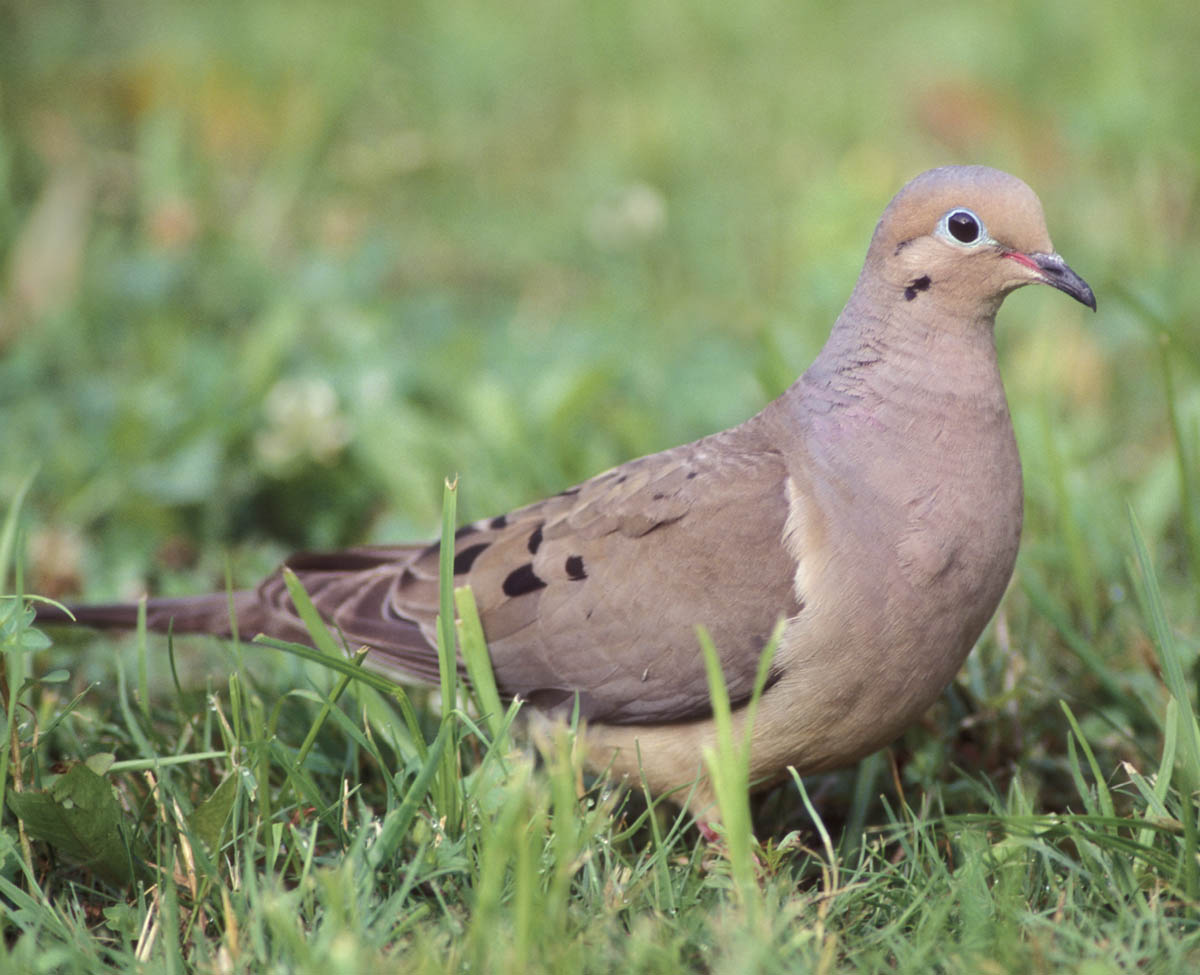
Mourning Dove adult
Although among the most abundant birds on the continent, Rock Pigeons and Mourning Doves are situated at opposite ends of the “bird popularity spectrum.” The Rock Pigeon’s North American population has been estimated at 12 million, which people consider far too many; some even call pigeons “flying rats” and other disparaging names.

Mourning Dove adult
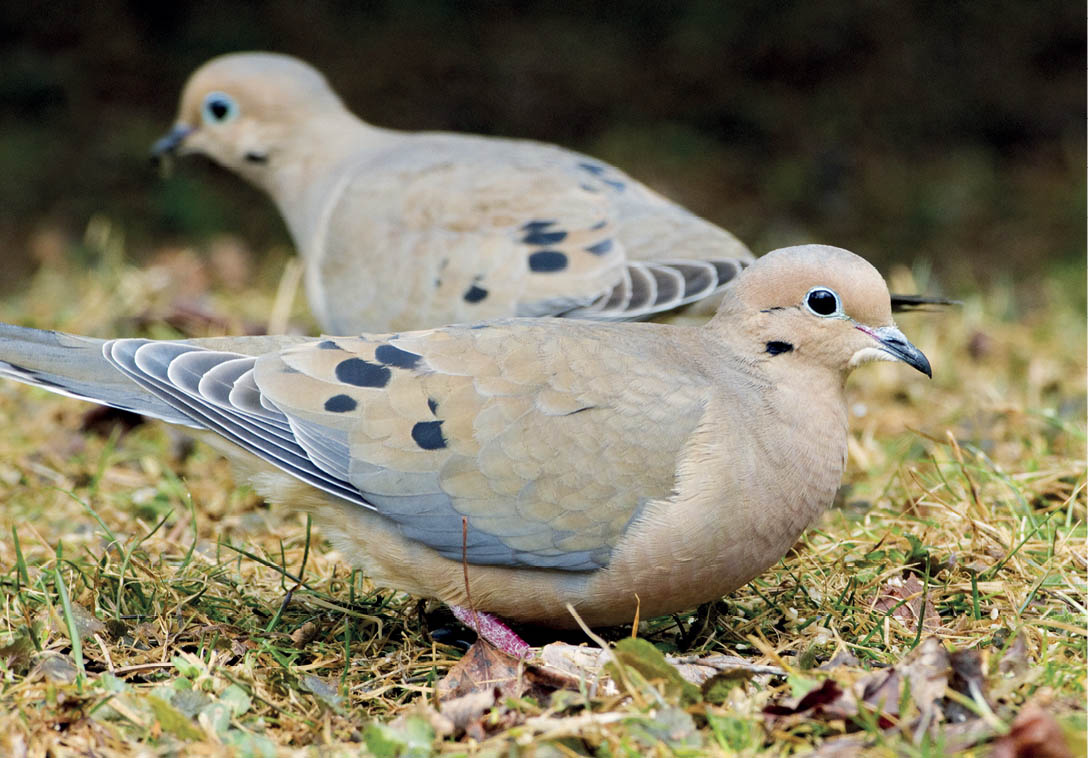
Paired Mourning Doves forage together on the ground. They stay close throughout the breeding season, during which time they may produce several broods of young.
The Mourning Dove is far more abundant, its population estimated at 100 million, but it’s one of the most treasured of backyard birds for its gentle ways and lovely calls. It’s also the most heavily hunted game bird in North America. About 20 million are harvested each year, far more than the total population of Rock Pigeons.
Doves are a favorite among natural predators as well, so most Mourning Doves don’t survive their first year. Those that do make it through all the challenges associated with each season have better prospects; after that first treacherous year, their life expectancy goes up dramatically. Many Mourning Doves bearing U.S. Fish and Wildlife Service numbered leg bands are known to have survived over 10 years, and one lived to be at least 30 years old. Rock Pigeons are not similarly banded, but people who breed and race them note that they often live well into their 30s. Feral pigeons that elude urban Peregrine Falcons and rat poison may survive similar lengths of time.
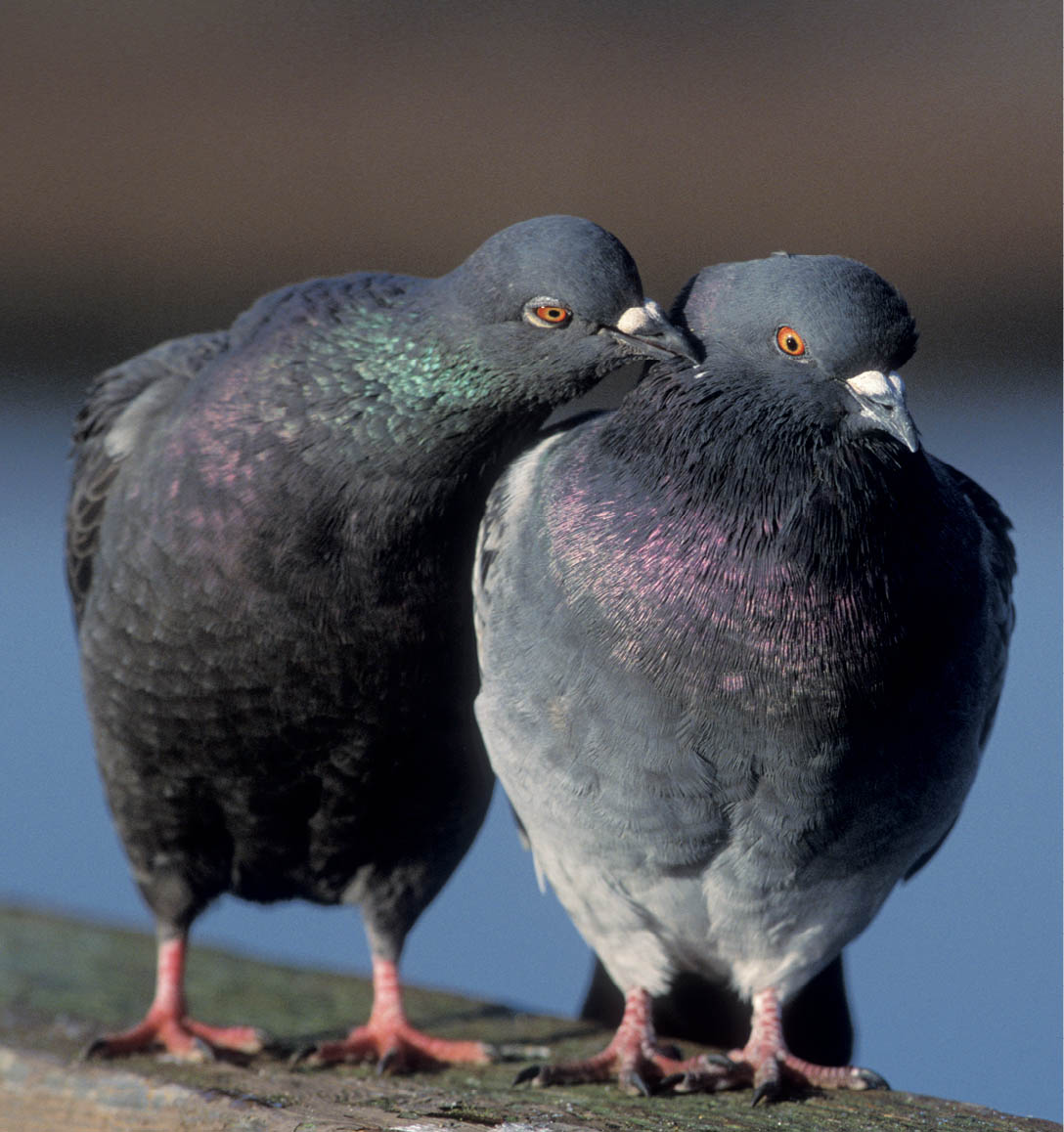
Rock Pigeons preen their mates, nibbling at the feathers around the face and neck. This allopreening is done by virtually all species of pigeons and doves during courtship.
Rock Pigeons and Mourning Doves are sociable, feeding, bathing, and roosting in flocks. This simplifies the task of finding an appropriate mate.
Female pigeons select their mate from the males that strut and display around them. Both sexes seem to prefer a mate that is about their own size and the youngest of the experienced adults available.
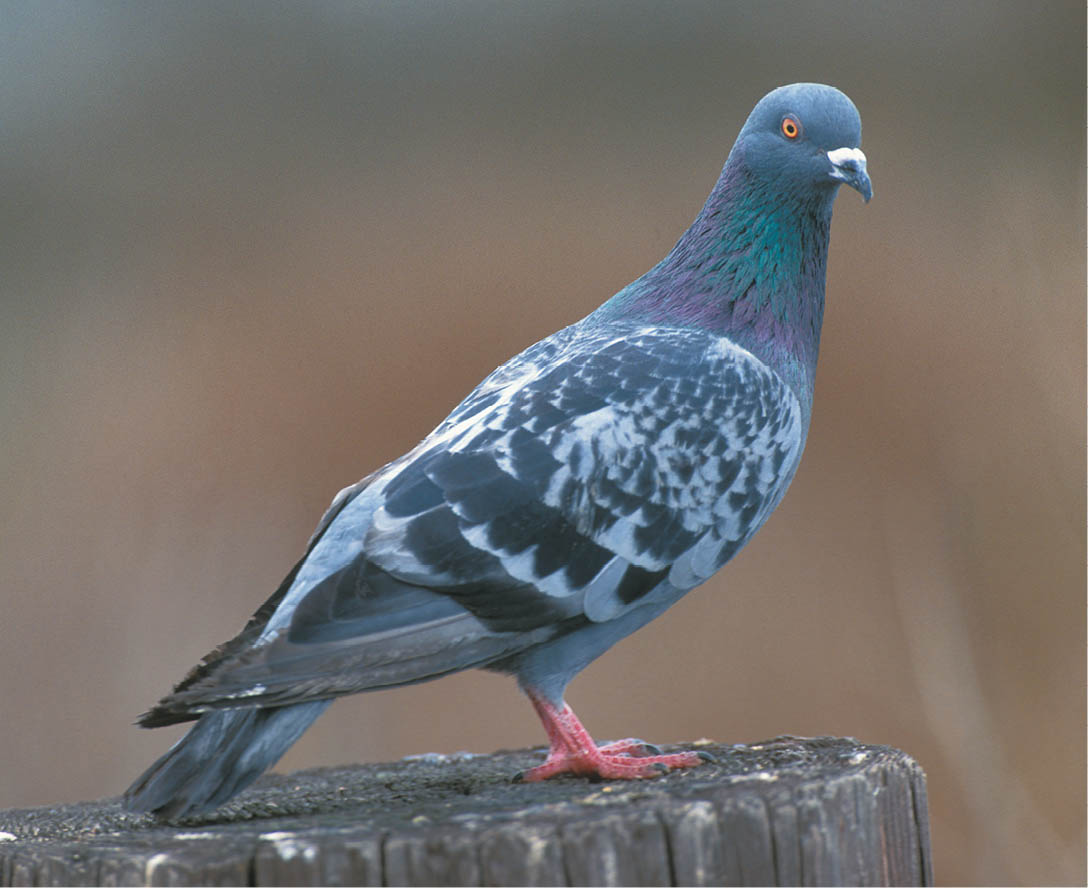
“Checker” Rock Pigeons have spots on the wings, as seen here. “Pied” types can be any color but are splotched with white.
An analysis of Pigeon Watch data from the Cornell Lab of Ornithology indicates that nearly 40 percent of all pigeon pairs are of matching colors, a trend strongest in birds of the dominant plumage, but other studies find that birds prefer mates with plumage different from their own. It’s hard for us to infer what the pigeons’ actual preferences are, and they’re not talking.
In early courtship, male pigeons bow and coo near a female while circling her many times. If she likes one, eventually she lets him preen her feathers, and she preens his. This mutual preening, or allopreening, strengthens the bond between them. If they maintain their mutual interest, the male feeds the female, sealing their pair bond.
Sometimes unattached males display at already paired females and drive them, pushily separating them from their mates. People who breed racing pigeons are careful to make sure paired pigeons fly only with other paired pigeons so they don’t get any inadvertent matings with unattached males.
As a pair bond is forming between two pigeons, the male searches out a good nest site: generally a flat surface under cover. Pigeons often nest on human-made structures, in nooks, crannies, or on ledges, often beneath the eaves or overhangs of buildings, under bridges, in stairwells, or on rain gutters. Rural pigeons may nest on cliff ledges or in barns and other farm buildings.
If everything clicks and the female accepts the nest site, they mate, often right out in the open. After copulation, male Rock Pigeons often take off in a dramatic display flight.
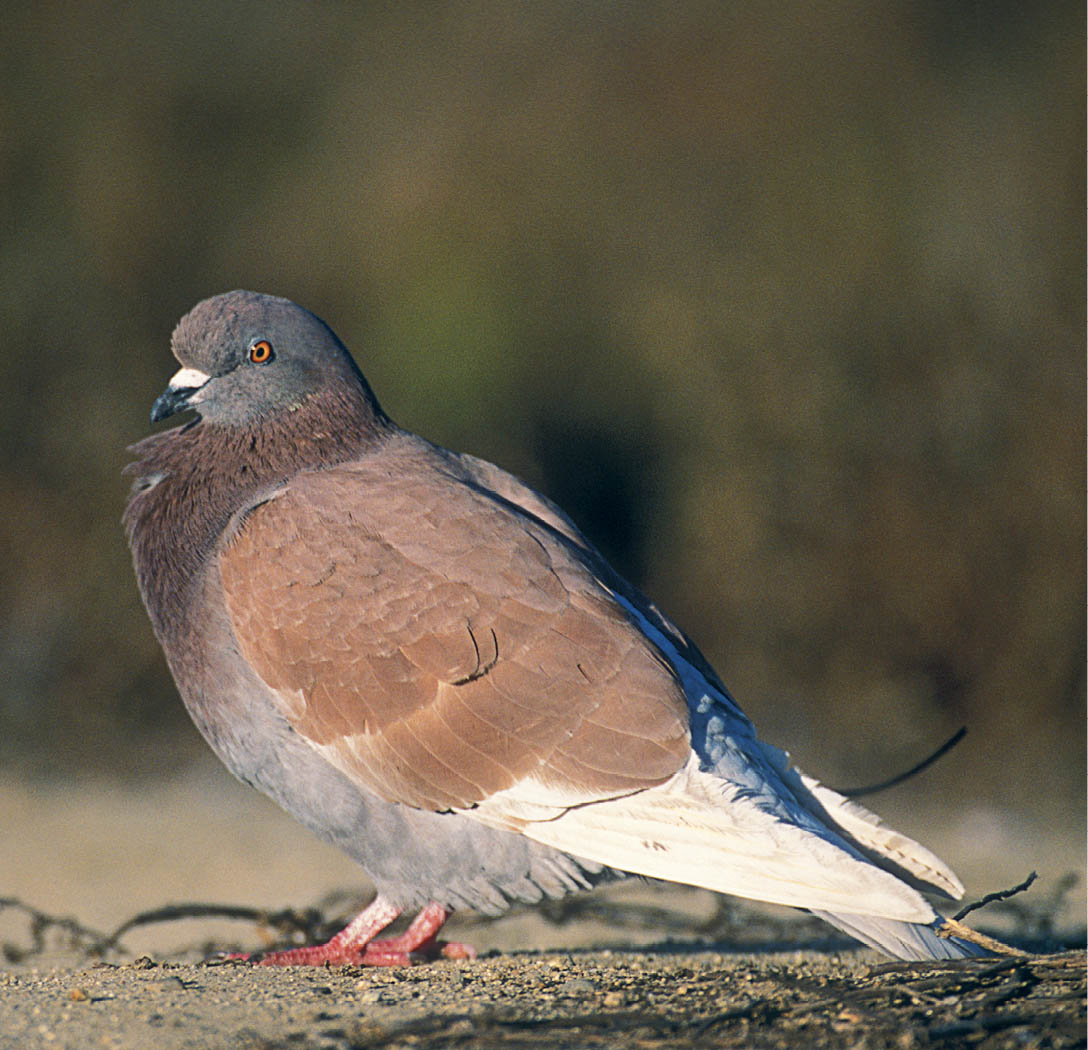
Pigeons with red plumage (this one has partly white wings) are more common in the southwestern United States than in the north or east.
In a study of captive doves, the dominant male and dominant female virtually always paired up and nested; lower-ranking pairs did not nest. In wild dove populations, males often outnumber females; unattached males spend a lot of time advertising each day by cooing from a conspicuous perch and then making a noisy flap-glide display flight. When a female alights near a displaying male, he usually approaches, his body raised and his head and tail held horizontally, and then bows his head and body. She may fly away (he’ll follow), ignore him, peck him, or crouch to allow mating.
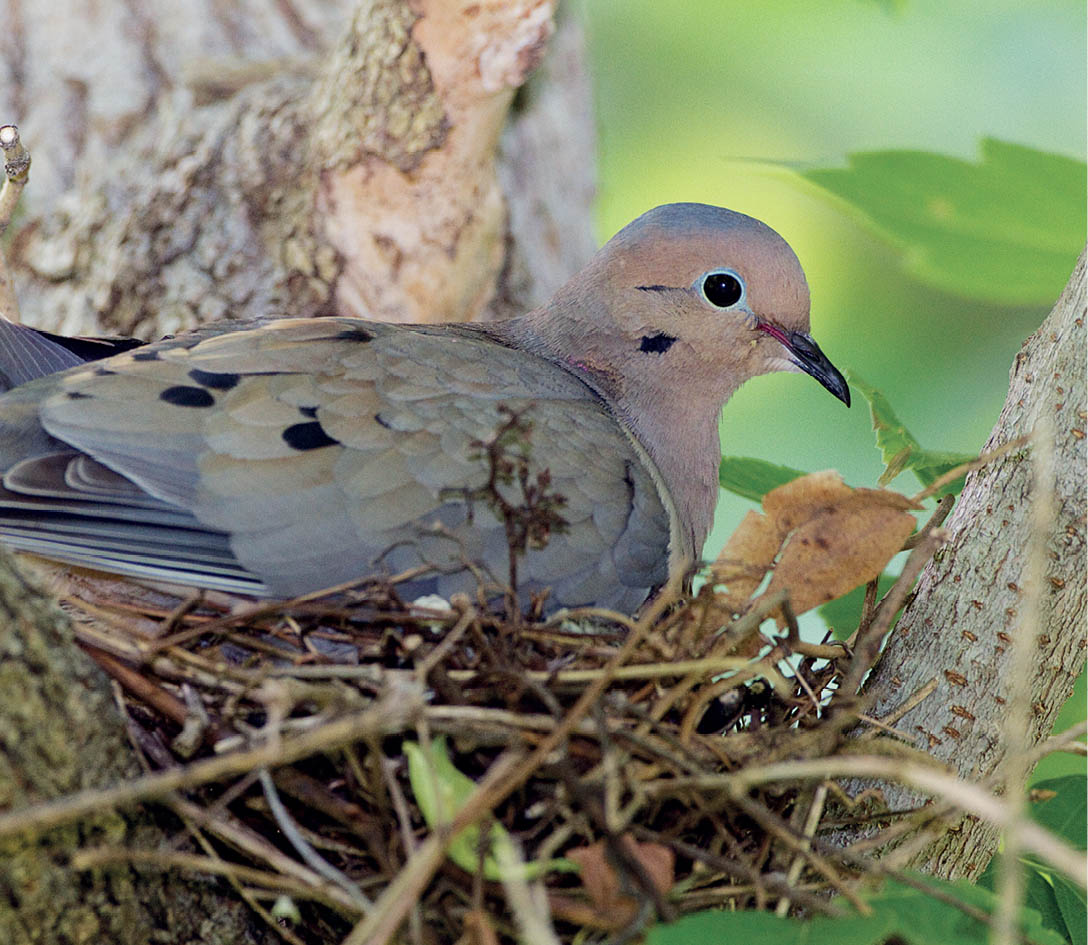
A Mourning Dove incubates on its nest. The pair shares the task of incubation; the male’s shift usually covers about mid-morning to late afternoon, when the female takes over for the rest of the 24-hour period. The eggs hatch in about 14 days.
After forming their bond they loaf around together for a few days while she gets physiologically ready to ovulate, and then they build their nest in a tree, shrub, hanging basket or other man-made structure, or on the ground. The male brings her nesting materials and then sits on her back as she puts them in place, literally looking over her shoulder as she works.
Mourning Dove nests are astonishingly flimsy. Some nests in trees and shrubs are so poorly constructed that one or both eggs fall through the loosely woven bottom. Pigeon nests are always on a solid substrate, so flimsiness isn’t a problem.

This urban Rock Pigeon is of the “spread” form, in which the plumage is all black or gray. Other forms are mostly red or mostly white.
Pigeons and doves all belong to the family Columbidae. People usually call larger species pigeons and ones with pointed tails doves, but there is no rule; the Eurasian Collared-Dove is large and the extinct Passenger Pigeon had a pointed tail. For many decades, the common city pigeon was called the Rock Dove; the American Ornithologists’ Union officially changed its name to Rock Pigeon in 2003.
Doves and pigeons lay two eggs in a clutch, and both parents take turns incubating, starting after the second egg is laid. In both species, the two spend about the same number of daylight hours on the eggs, the male taking the mid-morning to late afternoon shift while the female does night duty, from late afternoon until mid-morning. Dove eggs hatch in about 14 days; pigeons in 19.
Baby pigeons and doves, called squabs, are altricial, hatching with their eyes closed and their downy feathers very sparse. On the first day, they make little peeping sounds while barely lifting their heads and opening their bills for feedings, and they can’t regulate their body temperatures. At least one parent is present to brood them more than 99 percent of the time. Their eyes open at four to five days old.
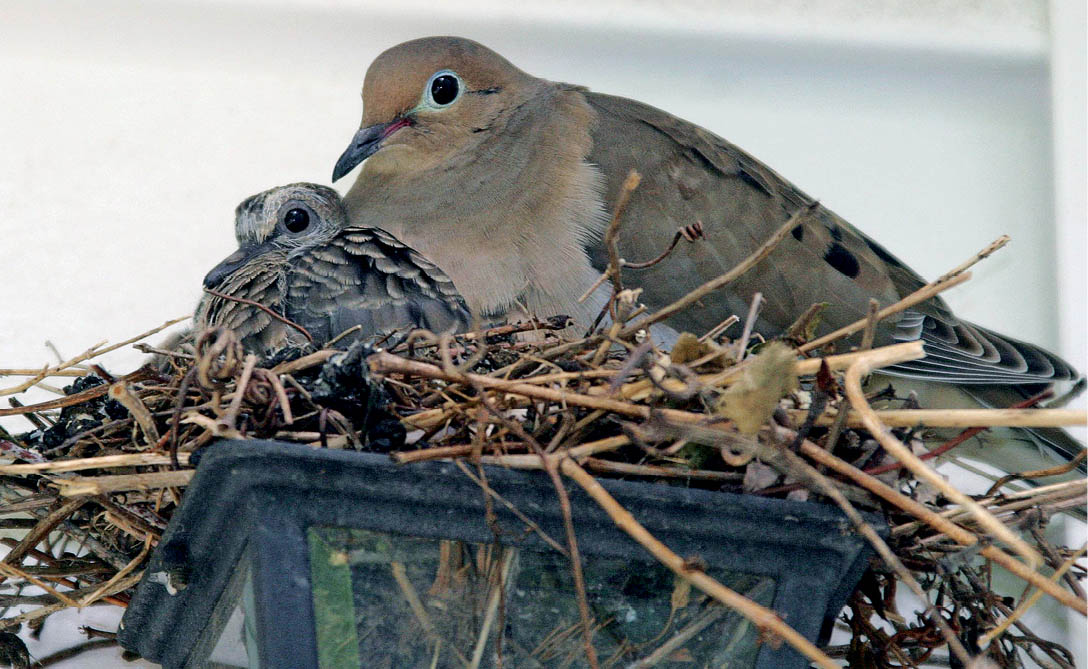
A Mourning Dove squab sits with its parent on a nest built on a light fixture. The youngster is well feathered enough that it no longer needs much brooding. Developing crown feathers suggest it is at least 10 days old, but it will not take its first flight until 13 to 15 days old.
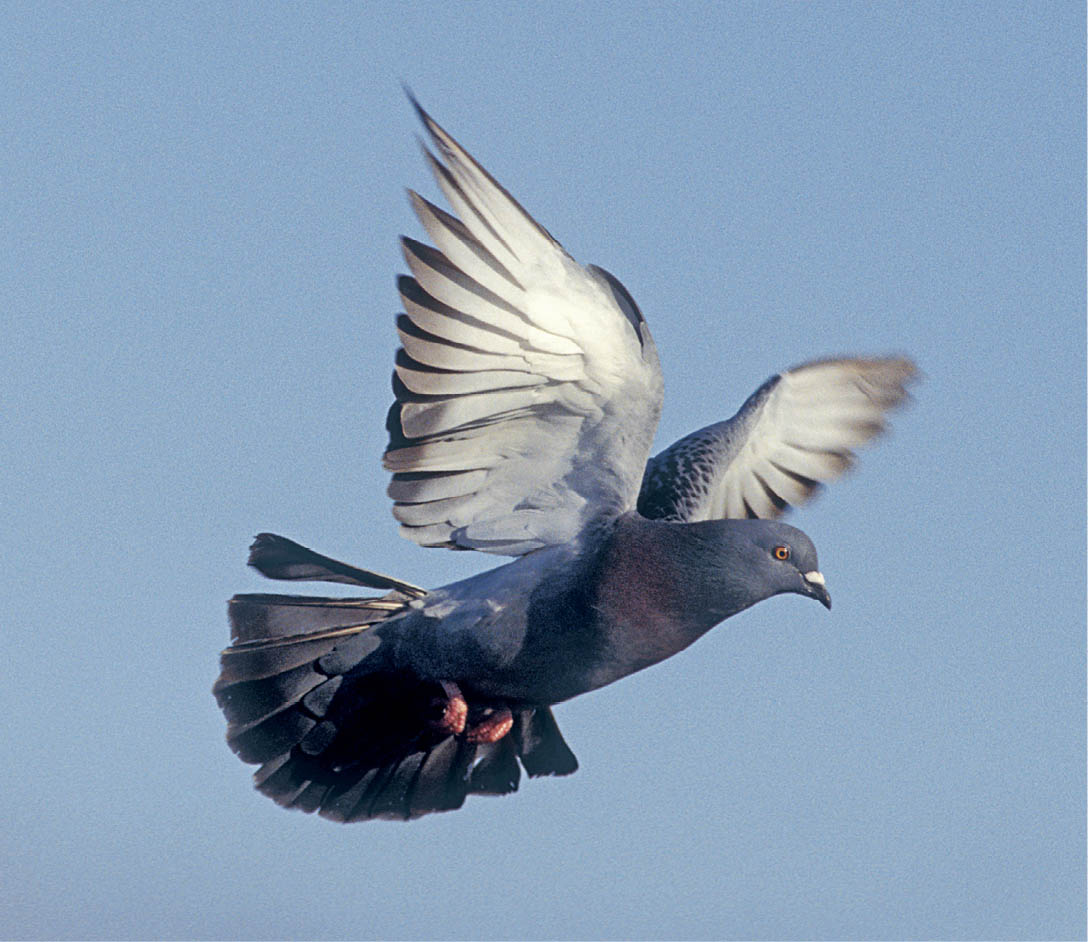
After copulation, a male pigeon flies near his nest site with wings held above his body in a V-shape. On takeoff, he loudly claps his wings together several times.
Rock Pigeon and Mourning Dove parents of both sexes feed the young a cheesy substance called pigeon milk or crop milk, produced in an enlarged chamber of the esophagus called the crop. This chamber is present in many species for food storage. In nesting pigeons and doves, however, the crop lining produces secretions and sloughs off cells to make this substance, which resembles yellowish cottage cheese and is rich in protein, fat, antioxidants, and immune-enhancing components. Squabs may face each other, each drinking from opposite sides of the parent’s bill simultaneously. Doves and pigeons are among the only birds that can suck, an ability that simplifies their feeding on crop milk.
During the first week, Rock Pigeon parents feed their nestlings large servings of crop milk three or four times each day. The parents eat soon after feeding the young and then fast before feeding them again, and thus no seeds are mixed with the crop milk. By the second week, the feeding rate drops to twice each day, though the young call and beg persistently. Little by little, as the chicks develop and get increasingly coordinated, regurgitated seeds will be mixed in with the crop milk.
Mourning Dove chicks start getting seeds mixed in with crop milk after about four days. The young fledge when 13 to 15 days old and continue to be fed by their parents (mostly the father) for another two weeks. Young, independent Mourning Doves associate with other young doves. Their scalloped plumage and slightly smaller size make them easy to distinguish from adults.
Rock Pigeons were nowhere to be found on the North American continent when Columbus arrived. In the early 1600s, colonists started bringing domesticated pigeons across the ocean for food and sport. Those that escaped captivity established feral populations. Now pigeons are everywhere people have settled on the continent, and especially abundant in urban settings. In their natural range in Europe, Asia, and Africa, Rock Pigeons nest on cliffs in crevices and caves; in America, they’re more likely to nest in crevices under bridges and on buildings.
Mourning Doves are native birds, nesting in a wide array of natural habitats, steering clear only of dense forests. They have adapted to a wide variety of nesting sites as well, usually in trees but sometimes directly on the ground or on human-made structures.
In summer, pigeons take their first flight when 25 to 32 days old; they may remain in the nest up to 45 days in winter. Within days of leaving, young pigeons can forage for themselves. By the time they are mingling with other street pigeons, they’re hard to distinguish from adults. A week or two later, the parents are already brooding new eggs.
Rock Pigeons can nest year-round, even in cold climates, as long as food for the parents is reasonably abundant and their nest site sheltered. Mourning Doves have a long breeding season, usually from February through October, shorter in the north, longer in the south. In both species, birds reach sexual maturity within months; males and females that hatch early in the year may start a whole new nesting cycle of their own that same year.
Baby pigeons and doves produce their droppings in pellet form, not in fecal sacs. Rock Pigeon parents ignore nest sanitation. The pellets, which accumulate as the parents produce brood after brood in the same nest, get stomped into the nesting materials and substrate, cementing the structure together. Mourning Dove parents eat the pellets of very young nestlings but ignore those of older nestlings. Those droppings accumulate around the edge of the nest. Mourning Doves usually build a new nest for each brood, only occasionally reusing one.
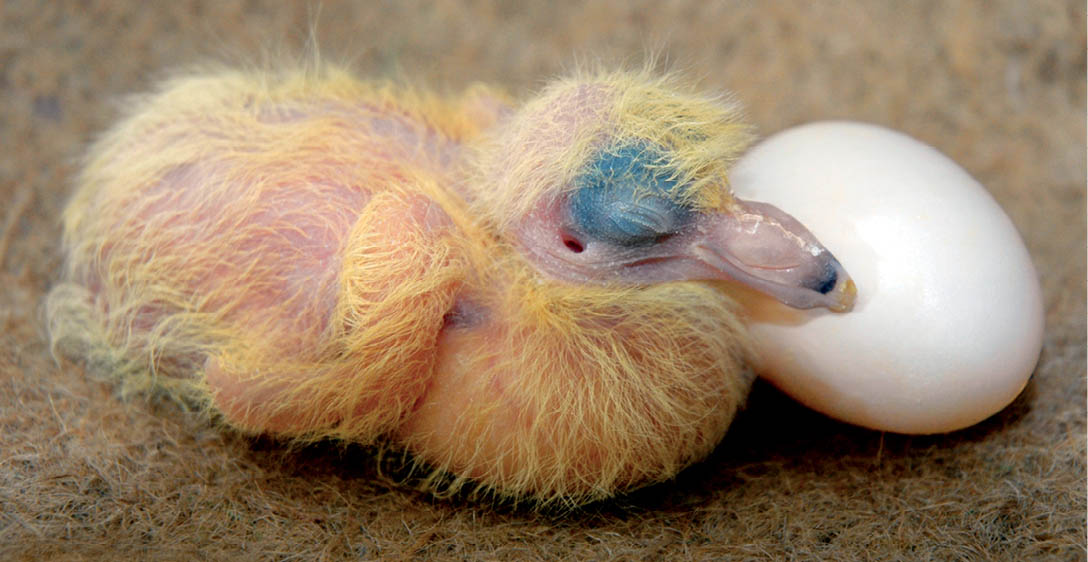
A newly hatched Rock Pigeon squab nestles next to an unhatched egg. The second egg usually hatches within a few hours. Notice the hole below the dark circular bulge of the still-closed eye: this is the bird’s ear opening.
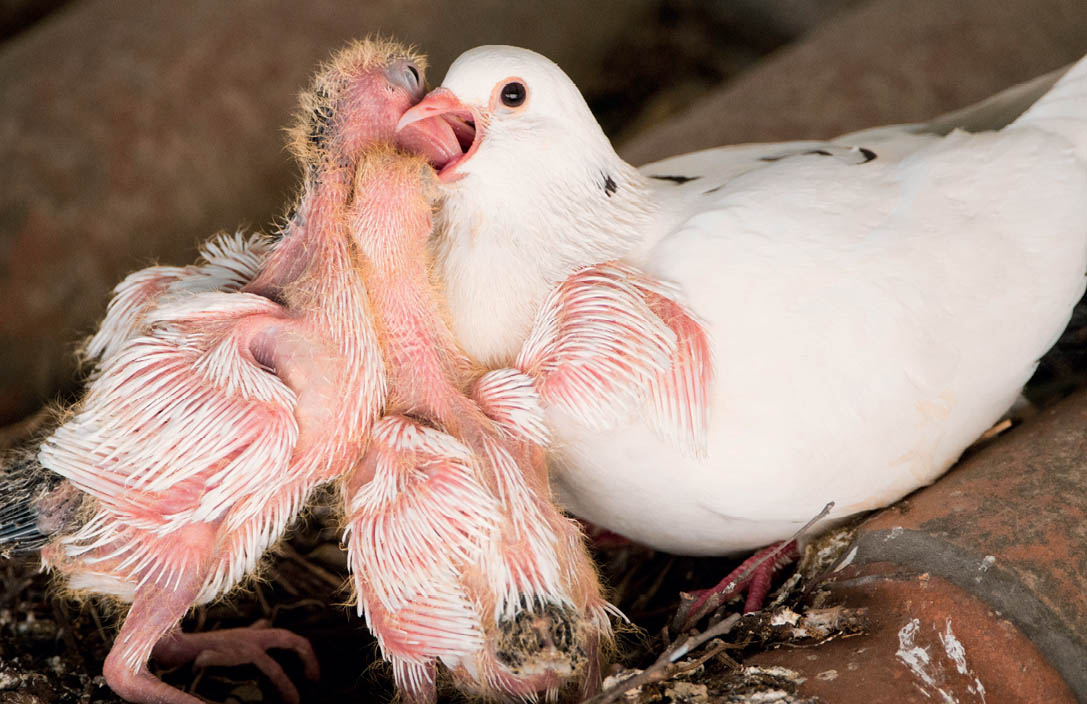
Two growing squabs plunge their bills into the parent’s open bill. For the first four days after hatching, young pigeons are fed only crop milk, which is rich in fat, protein and vitamins. Notice the developing feathers on the squabs’ wings and bodies.
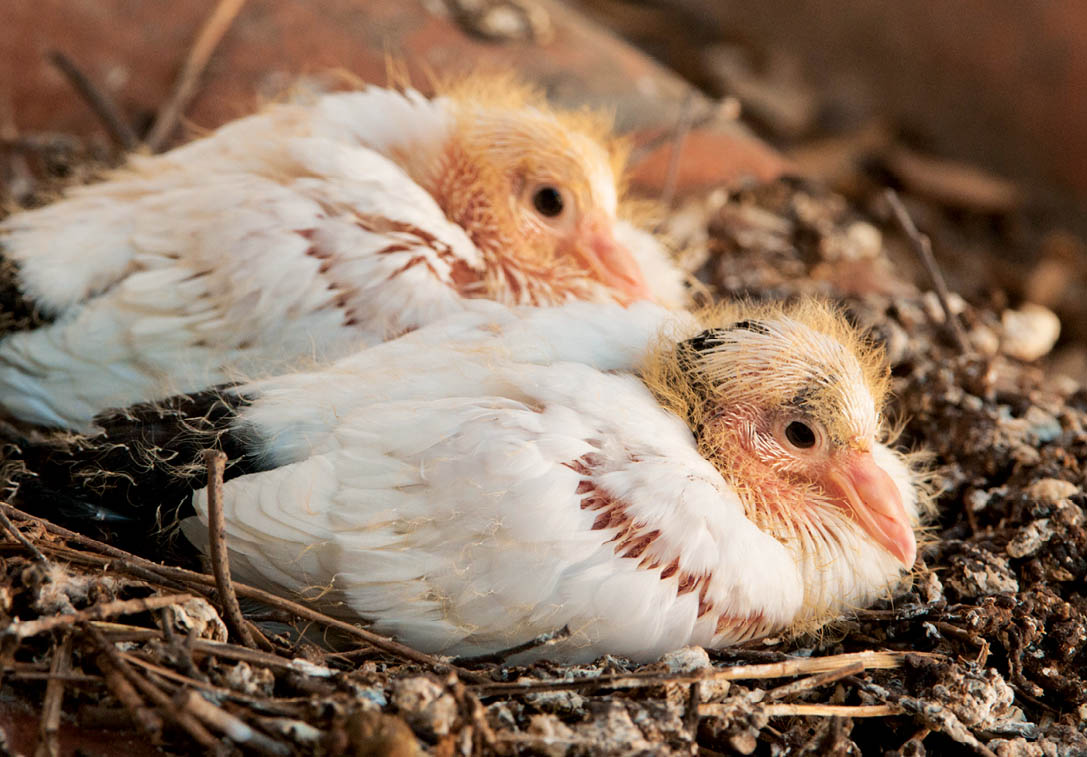
Two Rock Pigeon squabs about 14 days old. Their heads are still downy, but by now their wing and body feathers are well grown, although each feather is still encased by its sheath at the base. At this stage, they can walk well and often pursue the adults, begging for food.